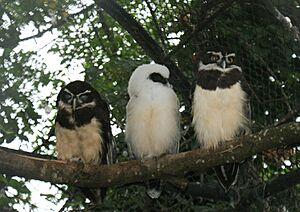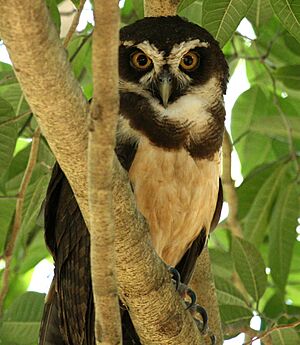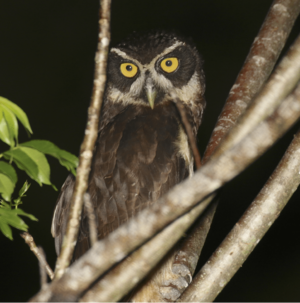Spectacled owl facts for kids
Quick facts for kids Spectacled owl |
|
|---|---|
 |
|
| In the rainforest of Costa Rica | |
| Conservation status | |
| Scientific classification | |
| Genus: |
Pulsatrix
|
| Species: |
perspicillata
|
 |
|
| The distribution of spectacled owl | |
The spectacled owl (Pulsatrix perspicillata) is a big, cool owl that lives in warm, tropical places. You can find it in forests from southern Mexico all the way down to Argentina. It also lives in Central America and on islands like Trinidad. This owl is a "resident breeder," meaning it stays in these areas and raises its young there. There are six different types, or subspecies, of spectacled owls.
Contents
Where Do Spectacled Owls Live?
Spectacled owls live in many countries across Central America and South America. This includes places like Mexico, Belize, Costa Rica, Panama, Colombia, Brazil, and Argentina. They also live on the islands of Trinidad and Tobago.
These owls mostly live in tropical rainforests. They prefer areas with lots of dense, old trees. However, they can sometimes be found in other places too. They might hunt along the edges of forests or in areas with some trees. Sometimes, they even live in dry forests or open areas with scattered trees. In places like Costa Rica, they can live in cloud forests up to 1,500 meters (about 4,900 feet) high.
What Does a Spectacled Owl Look Like?
Spectacled owls are medium to large-sized owls. They can be about 41 to 52 centimeters (16 to 20 inches) long. Male owls usually weigh between 453 and 1,075 grams (1 to 2.4 pounds). Females are a bit heavier, weighing from 680 to 1,250 grams (1.5 to 2.8 pounds).
These owls are easy to spot because of their unique look. They have dark brownish-black feathers on their back, head, and upper chest. Their face has white markings that look like "spectacles" or glasses around their bright yellow eyes. Their belly is a lighter, yellowish-white color. The only other owls with yellow eyes in their group are the spectacled owls. Their beak is a pale color.
How Do Young Spectacled Owls Look?
Young spectacled owls look very different from the adults. They are mostly white with a dark brown face. This makes them even more unique! As they grow, their feathers change to the adult colors.
How Do Spectacled Owls Sound?
Spectacled owls are most vocal on clear, moonlit nights. Their main call sounds like knocking or tapping. It's like a "PUP-pup-pup-pup-po" or "POK pok pok bog bog bog bobobo." Each sound gets a bit softer and lower as the call continues.
The male owl usually sings to mark his territory. He often sings from the top of a tall tree. Female owls also sing, but their calls are higher pitched. Sometimes, a pair of owls will sing together on moonlit nights. Females also make a loud, hawk-like scream that sounds like a steam whistle: "ker-WHEEER." Baby owls make a harsh, high-pitched "keew" sound when they want food.
Different Types of Spectacled Owls
There are six recognized subspecies, or types, of spectacled owls:
- Pulsatrix perspicillata boliviana: This type lives in Bolivia. It has slightly lighter colors than some other types.
- Pulsatrix perspicillata chapmani: Found from Costa Rica to northwestern Ecuador. This one is darker, with sooty black on its back.
- Pulsatrix perspicillata perspicillata: This is the most widespread type. It lives across much of northwestern South America and into Brazil.
- Pulsatrix perspicillata pulsatrix: Also called the "Short-browed Owl." It lives in southeastern Brazil and northeastern Argentina. This type has creamy-buff "spectacles" instead of white ones. It's also lighter brown overall.
- Pulsatrix perspicillata saturata: Found from southern Mexico to northern Costa Rica. This type has a black head and back, with black stripes on its sides.
- Pulsatrix perspicillata trinitatis: This type lived on Trinidad and Tobago. Sadly, experts believe this type is now extinct.
How Spectacled Owls Behave

Spectacled owls are mostly active at night. They start moving around when the sun sets and usually return to their roosting spots before sunrise. They are solitary birds, meaning they usually like to be alone. They only spend time with other owls when it's time to mate and raise young.
What Do Spectacled Owls Eat?
These owls are usually the biggest and strongest owls in their habitat. They hunt by sitting on a branch and watching for prey. Once they spot something, they quickly pounce on it. They mainly eat a variety of mammals that are active at night. This includes many types of rodents and even small monkeys.
They can catch prey that is heavier than they are! For example, they might hunt large opossums or skunks. There's even a report of a spectacled owl killing a three-toed sloth, which can weigh more than four times the owl's weight!
Besides mammals, they also eat invertebrates like caterpillars, crabs, snails, and large insects. They might even eat frogs. They also hunt birds, usually medium-sized ones like jays and pigeons, catching them while they are sleeping on branches.
Spectacled Owl Reproduction and Life Cycle
In Costa Rica, spectacled owls lay their eggs during the dry season (November to May) or early wet season (June to July). They don't build a fancy nest. Instead, they lay their eggs in a natural tree cavity or a large tree's branch fork. They just lay the eggs on the bare wood, often rotting wood inside the tree.
Female owls lay one or two eggs. The female does most, if not all, of the incubating for about five weeks. If two chicks hatch, often only one will survive. The smaller chick might not get enough food or could be pushed out by its stronger sibling.
The young owls leave the nest for nearby branches when they are about 5 to 6 weeks old. At this age, they can't fly very well yet. They stay with their parents for several months after leaving the nest. Their parents continue to feed and care for them for up to a year. This long period of care means the parents might not have new young the very next year. Spectacled owls can even start breeding before they have their full adult feathers, which can take up to five years to get.
What is the Spectacled Owl's Status?
The spectacled owl lives across a very large area and is still common in many parts of its range. Because of this, the IUCN (International Union for Conservation of Nature) lists it as a species of "Least Concern." This means it's not currently in danger of extinction.
However, these are large birds of prey that mature slowly and need a lot of space. So, they naturally live in small numbers. In places where people hunt their prey or destroy their forest homes, their numbers can decrease. This is likely why one type of spectacled owl on Trinidad (P. p. trinitatis) is now extinct. Sometimes, owls are also hit by cars when new roads are built through their forest habitats.
Gallery









